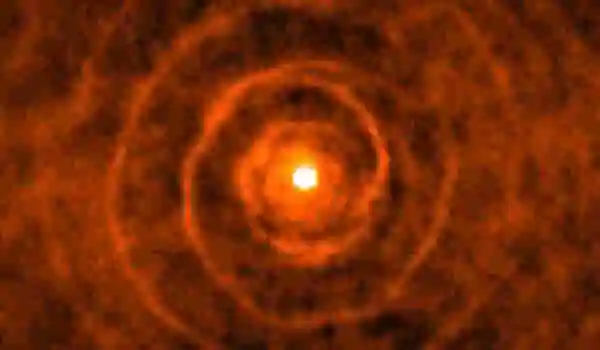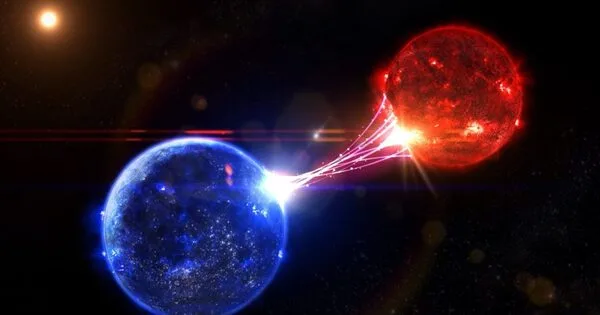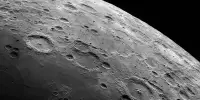University of Toronto astronomers have discovered a population of massive stars that have been stripped of their hydrogen envelopes by their binary system companions. The findings, which were published in Science Today, shed light on hot helium stars, which are thought to be the origins of hydrogen-poor core-collapse supernovae and neutron star mergers.
For more than a decade, scientists have hypothesized that one in every three massive stars is stripped of its hydrogen envelope in binary systems. Despite this, only one possible candidate has been identified up until now.
“This was such a big, glaring hole,” says co-lead author Maria Drout, an Assistant Professor in the David A. Dunlap Department of Astronomy & Astrophysics at the University of Toronto and a Dunlap Institute for Astronomy & Astrophysics Associate.
“If it turned out that these stars are rare, then our whole theoretical framework for all these different phenomena is wrong, with implications for supernovae, gravitational waves, and the light from distant galaxies,” Drout said. “This finding shows these stars really do exist.”
“Going forward, we are going to be able to do much more detailed physics with these stars,” Drout said. “For example, predictions for how many neutron star mergers we should see are dependent on these stars’ properties, such as how much material comes off of them in stellar winds.” We’ll be able to measure it for the first time, rather than extrapolating it previously.”
Our work sheds light on these fascinating relationships, revealing a universe that is far more interconnected and active than we previously imagined. Just as humans are social beings, stars too, especially the massive ones, are rarely alone.
Maria Ludwig
Binary-stripped stars have previously been invoked to explain why one-third of core-collapse supernovae contain far less hydrogen than a typical Red Supergiant star explosion. According to Drout and her colleagues, these newly discovered stars will eventually explode as hydrogen-poor supernovae. These star systems are also thought to be necessary to form neutron star mergers, like those that emit gravitational waves detected from Earth by the LIGO experiment.
In fact, the researchers believe that a few objects in their current sample are stripped stars with neutron stars or black hole companions. These objects are at the stage immediately before they become double neutron stars or neutron stars plus black hole systems that could eventually merge.
“Many stars are part of a cosmic dance with a partner, orbiting each other in a binary system. They’re not solitary giants but part of dynamic duos, interacting and influencing each other throughout their lifetimes,” says Bethany Ludwig, a Ph.D. student in the David A. Dunlap Department of Astronomy & Astrophysics at the University Toronto and the third author on this paper. “Our work sheds light on these fascinating relationships, revealing a universe that is far more interconnected and active than we previously imagined.”
“Just as humans are social beings, stars too, especially the massive ones, are rarely alone,” Ludwig says.

As stars evolve and expand to become red giants, the gravitational pull of their companion can strip the hydrogen from their outer edges, exposing a very hot helium core. It is possible that the process will take tens of thousands, if not hundreds of thousands, of years.
Stripped stars are difficult to find because much of the light they emit is outside of the visible light spectrum and can be obscured by cosmic dust or outshone by their companion stars.
Drout and her colleagues began their hunt in 2016. After studying hydrogen-poor supernovae for her PhD, Drout set out on a NASA Hubble Postdoctoral Fellowship at the Carnegie Institution for Science to find the stripped stars thought to be at the heart of them. At a conference, she met fellow co-author Ylva Götberg, now Assistant Professor at the Institute of Science and Technology Austria (ISTA), who had recently developed new theoretical models of how these stars should look.
Drout, Götberg, and their colleagues devised a new survey to investigate the ultraviolet region of the spectrum, where extremely hot stars emit the majority of their light. While ultraviolet light is invisible to the naked eye, it can be detected by specialized instruments and telescopes.
Using data from the Swift Ultra-Violet/Optical Telescope, the researchers collected brightnesses for millions of stars in the Large and Small Magellanic Clouds, two of the closest galaxies to Earth. Ludwig developed the first wide-field UV catalog of the Magellanic Clouds and used UV photometry to detect systems with unusual UV emissions, signaling the possible presence of a stripped star.
Between 2018 and 2022, they conducted a pilot study on 25 objects, obtaining optical spectroscopy with the Magellan Telescopes at Las Campanas Observatory. They used these observations to show that the stars were hot, small, low in hydrogen, and in binary systems, all of which were predicted by their model.
The researchers are currently studying the stars identified in this paper and expanding their search for more. They will use approved programs on the Hubble Space Telescope, the Chandra X-Ray Telescope, the Magellan Telescopes, and the Anglo-Australian Telescope to look both within nearby galaxies and within our own Milky Way. All theoretical models and data used to identify these stars have been made public and available to other scientists as part of this publication.
















